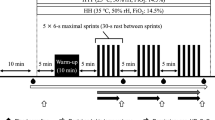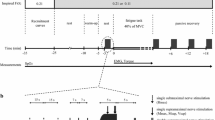Abstract
Purpose
We examined the effect of ischemic preconditioning (IPC) on changes in muscle force, activation, and the spinal reflex pathway during and after repeated sprint cycling.
Methods
Eight recreationally active men (high-intensity cardiorespiratory training > 3 times per week, > 6 months) completed two exercise sessions (5 sets of 5 cycling sprints, 150% max W), preceded by either IPC (3 × 5 min leg occlusions at 220 mmHg) or SHAM (3 × 5 min at 20 mmHg). Knee extensor maximal force and rate of force were measured before (PRE), immediately post (POST), 1H, and 24H after cycling. Twitch interpolation and resting potentiated twitches were applied to estimate voluntary activation and muscle contractility, respectively. Quadriceps H-reflex recruitment curves were collected at all time-points using 10 Hz doublet stimulation to allow estimation of H-reflex post-activation depression. Surface electromyograms and tissue oxygenation (via near-infrared spectroscopy) were continuously recorded during cycling.
Results
IPC did not affect any measure of neuromuscular function or performance during cycling. Maximal force and muscle contractility were significantly lower at POST and 1H compared to PRE and 24H by up to 50% (p < 0.01). Maximal force was lower than PRE at 24H by 8.7% (p = 0.028). Voluntary activation and rate of force were unchanged. A rightwards shift was observed for the H-reflex recruitment curve POST, and post-activation depression was higher than all other time-points at 24H (p < 0.05). Muscle activation and oxygenation decreased during cycling.
Conclusions
IPC has a nominal effect on mechanisms associated with neuromuscular function during and after exercise in healthy populations.





Similar content being viewed by others
Abbreviations
- ½ RT:
-
Half relaxation time
- ANOVA:
-
Analysis of variance
- H-reflex:
-
Hoffman reflex
- BW:
-
Bodyweight
- DeOxyHb:
-
Deoxygenated hemoglobin
- IPC:
-
Ischemic preconditioning
- MVC:
-
Maximal voluntary isometric contraction
- M-wave:
-
Muscle compound action potential
- NIRS:
-
Near-infrared spectroscopy
- Q .pot.tw :
-
Quadriceps resting potentiated twitch
- RSE:
-
Repeated sprint cycling exercise
- RMS:
-
Root mean square
- sEMG:
-
Surface electromyogram
- TPT:
-
Time to peak twitch
- TSI:
-
Muscle tissue oxygenation saturation
- VA:
-
Voluntary activation
- VL:
-
Vastus lateralis
- VM:
-
Vastus medialis
- vRTD:
-
Voluntary rate of torque development
- W:
-
Watts
References
Aagaard P, Simonsen E, Andersen J, Magnusson P, Dyhre-Poulsen P (2002) Increased rate of force development and neural drive of human skeletal muscle following resistance training. J Appl Physiol 93:1318–1326
Allison GT (2003) Trunk muscle onset detection technique for EMG signals with ECG artefact. J Electromyogr Kinesiol 13:209–216
Andreas M, Schmid AI, Keilani M (2011) Effect of ischemic preconditioning in skeletal muscle measured by functional magnetic resonance imaging and spectroscopy: a randomized crossover trial. J Cardiovasc Magn Reson 13:13–32
Bailey TG, Jones H, Gregson W, Atkinson G, Cable NT, Thijssen DH (2012) Effect of ischemic preconditioning on lactate accumulation and running performance. Med Sci Sports Exerc 44:2084–2089
Barbosa TC, Machado AC, Braz ID, Fernandes IA, Vianna LC, Nobrega AC, Silva BM (2015) Remote ischemic preconditioning delays fatigue development during handgrip exercise. Scand J Med Sci Sports 25:356–364
Baudry S, Maerz AH, Gould JR, Enoka RM (2011) Task- and time-dependent modulation of Ia presynaptic inhibition during fatiguing contractions performed by humans. J Neurophysiol 106:265–273
Behm DG, St-Pierre DMM, Perez D (1996) Muscle inactivation: assessment of interpolated twitch technique. J Appl Physiol 81:2267–2273
Billaut F, Kerris JP, Rodriguez RF, Martin DT, Gore C, Bishop DJ (2013) Interaction of central and peripheral factors during repeated sprints at different levels of arterial O2 saturation. PLoS One 8:e77297
Brinkworth RSA, Tuncer M, Tucker KJ, Jaberzadeh S, Turker KS (2007) Standardization of H-reflex analyses. J Neurosci Methods 162:1–7
Crisafulli A, Tangianu F, Tocco F, Concu A, Mameli O, Mulliri G, Caria MA (2011) Ischemic preconditioning of the muscle improves maximal exercise performance but not maximal oxygen uptake in humans. J Appl Physiol 111:530–536
Cruz RS, de Aguiar RA, Turnes T, Pereira KL, Caputo F (2015) Effects of ischemic preconditioning on maximal constant-load cycling performance. J Appl Physiol 119:961–967
Cruz RS, de Aguiar RA, Turnes T, Salvador AF, Caputo F (2016) Effects of ischemic preconditioning on short-duration cycling performance. Appl Physiol Nutr Metab 41:825–831
Cruz RS, Pereira KL, Lisboa FD, Caputo F (2017) Could small-diameter muscle afferents be responsible for the ergogenic effect of limb ischemic preconditioning? J Appl Physiol 122:718–720
de Groot PCE, Thijssen DHJ, Sanchez M, Ellenkamp R, Hopman MTE (2010) Ischemic preconditioning improves maximal performance in humans. Eur J Appl Physiol 108:141–146
Del Vecchio A, Negro F, Felici F, Farina D (2017) Associations between motor unit action potential parameters and surface EMG features. J Appl Physiol 123:835–843
Doguet V, Jubeau M (2014) Reliability of H-reflex in vastus lateralis and vastus medialis muscles during passive and active isometric conditions. Eur J Appl Physiol 114:2509–2519
Garland SJ, McComas AJ (1990) Reflex inhibition of human soleus muscle during fatigue. J Physiol 429:17–27
Halley SL, Marshall PWM, Siegler JC (2018) The effect of ischaemic preconditioning on central and peripheral fatiguing mechanisms in humans following sustained maximal isometric exercise. Exp Physiol 103:976–984
Halley SL, Marshall PW, Siegler JC (2019a) The effect of ischemic preconditioning and changing inspired O2 fractions on neuromuscualr function during intense exercise. J Appl Physiol. https://doi.org/10.1152/japplphysiol.00539.2019
Halley SL, Marshall PWM, Siegler JC (2019b) The effect of IPC on central and peripheral fatiguing mechanisms in humans following maximal single limb isokinetic exercise. Physiol Rep 7:e14063
Hyngstrom AS, Murphy SA, Nguyen J, Schmidt BD, Negro F, Gutterman DD, Durand MJ (2018) Ischemic conditioning increases strength and volitional activation of paretic muscle in chronic stroke: a pilot study. J Appl Physiol 124:1140–1147
Johnson ST, Kipp K, Norcross MF, Hoffman MA (2015) Spinal and supraspinal motor control predictors of rate of torque development. Scand J Med Sci Sports 25:623–629
Kipp K, Johnson ST, Doeringer JR, Hoffman MA (2011) Spinal reflex excitability and homosynaptic depression after a bout of whole-body vibration. Muscle Nerve 43:259–262
Klimstra M, Zehr P (2008) A sigmoid function is the best fit for the ascending limb of the Hoffmann reflex recruitment curve. Exp Brain Res 186:93–105
Knikou M (2008) The H-reflex as a probe: Pathways and pitfalls. J Neurosci Methods 171:1–12
Lukes DJ, Lundgren A, Skogsberg U, Karlsson-Parra A, Soussi B, Olausson M (2005) Ischemic preconditioning can overcome the effect of moderate to severe cold ischemia on concordant mouse xeno-heart transplants. Transplant Proc 37:3332–3334
Marocolo M, Billaut F, da Mota GR (2018) Ischemic preconditioning and exercise performance: an ergogenic aid for whom? Front Physiol 8:1874
Marshall PWM, Cross R, Lovell R (2015a) Passive heating following the prematch warm-up in soccer: examining the time-course of changes in muscle temperature and contractile function. Phys Rep 3:e12635
Marshall PWM, Finn HT, Siegler JC (2015b) The magnitude of peripheral muscle fatigue induced by high and low intensity single-joint exercise does not lead to central motor output reductions in resistance trained men. PLoS ONE 10:e0140108
Marshall PWM, Cross R, Haynes M (2018) The fatigue of a full body resistance exercise session in trained men. J Sci Med Sport 21:422–426
Merton PA (1954) Voluntary strength and fatigue. J Physiol 123:553–564
Metcalf E, Hagstrom AD, Marshall PW (2019) Trained females exhibit less fatigability than trained males after a heavy knee extensor resistance exercise session. Eur J Appl Physiol 119:181–190
Murry CE, Jennings RB, Reimer KA (1986) Preconditioning with ischemia: a delay of lethal cell injury in ischemic myocardium. Circulation 74:1124–1136
Nordlund MM, Thorstensson A, Cresswell AG (2004) Central and peripheral contributions to fatigue in relation to level of activation during repeated maximal voluntary isometric plantar flexions. J Appl Physiol 96:218–225
Papaiordanidou M, Guiraud D, Varray A (2010) Kinetics of neuromuscular changes during low-frequency electrical stimulation. Muscle Nerve 41:54–62
Paradis-Deschênes P, Joanisse DR, Billaut F (2016) Ischemic preconditioning increases muscle perfusion, oxygen uptake, and force in strength-trained athletes. Appl Physiol Nutr Metab 41:938–944
Patterson SD, Bezodis NE, Glaister M, Pattison JR (2015) The effect of ischemic preconditioning on repeated sprint cycling performance. Med Sci Sports Exerc 47:1652–1658
Saito T, Komiyama T, Aramoto H, Miyata T, Shigematsu H (2004) Ischemic preconditioning improves oxygenation of exercising muscle in vivo. J Surg Res 120:111–118
Salvador AF, De Aguiar RA, Lisboa FD, Pereira KL, Cruz RS, Caputo F (2016) Ischemic preconditioning and exercise performance: a systematic review and meta-analysis. Int J Sports Physiol Perform 11:4–14
Sidhu SK et al (2018) Fatigue-related group III/IV muscle afferent feedback facilitates intracortical inhibition during locomotor exercise. J Physiol 596:4789–4801
Siegler JC, Marshall PWM, Poulsen MK, Nielsen NP, Kennedy D, Green S (2015) The effect of pH on fatigue during submaximal isometric contractions of the human calf muscle. Eur J Appl Physiol 115:565–577
Stokfisz K, Ledakowicz-Polaka A, Zagorskib M, Zielinskaa M (2017) Ischaemic preconditioning—current knowledge and potential future applications after 30 years of experience. Adv Med Sci 62:307–316
Strojnik V, Komi PV (1998) Neuromuscular fatigue after maximal stretch-shortening cycle exercise. J Appl Physiol 84:344–350
Subudhi AW, Dimmen AC, Roach RC (2007) Effects of acute hypoxia on cerebral and muscle oxygenation during incremental exercise. J Appl Physiol 103:177–183
Trimble MH, Du P, Brunt D, Thompson FJ (2000) H-reflexes as a function of the reflex activation history during standing and stepping. Brain Res 858:274–283
Upton AR, McComas AJ, Sica RE (1971) Potentiation of “late” responses evoked in muscles during effort. J Neurol Neurosurg Psychiatry 34:699–711
Van Beekvelt MC, Colier WN, Wevers RA, Van Engelen BG (2001) Performance of near-infrared spectroscopy in measuring local O2 consumption and blood flow in skeletal muscle. J Appl Physiol 90:511–519
Vila-Cha C, Falla D, Correia MV, Farina D (2012) Changes in H-reflex and V wave following short-term endurance and strength training. J Appl Physiol 112:54–63
Weavil JC, Amann M (2018) Corticospinal excitability during fatiguing whole body exercise. Prog Brain Res 240:219–246
Weavil JC, Sidhu SK, Mangum TS, Richardson RS, Amann M (2016) Fatigue diminishes motoneuronal excitability during cycling exercise. J Neurophysiol 116:1743–1751
Acknowledgements
Funding was received for this study from the School of Science and Health, Western Sydney University. Author SH received funding support for a Ph.D. scholarship from Westfield Sports High. Authors SR and MK received travel support from Aalborg University.
Author information
Authors and Affiliations
Contributions
All authors conceived and designed the research. PM, SB, and MK conducted the experiments. PM, SB, and MK processed and analysed the data. All authors contributed to the final editing and revision of the manuscript. All authors have read and approved the final manuscript.
Corresponding author
Ethics declarations
Conflict of interest
The authors declare that they have no conflicts of interest.
Additional information
Communicated by Nicolas Place.
Publisher's Note
Springer Nature remains neutral with regard to jurisdictional claims in published maps and institutional affiliations.
Rights and permissions
About this article
Cite this article
Marshall, P.W., Rasmussen, S.B., Krogh, M. et al. Changes in the quadriceps spinal reflex pathway after repeated sprint cycling are not influenced by ischemic preconditioning. Eur J Appl Physiol 120, 1189–1202 (2020). https://doi.org/10.1007/s00421-020-04359-9
Received:
Accepted:
Published:
Issue Date:
DOI: https://doi.org/10.1007/s00421-020-04359-9




